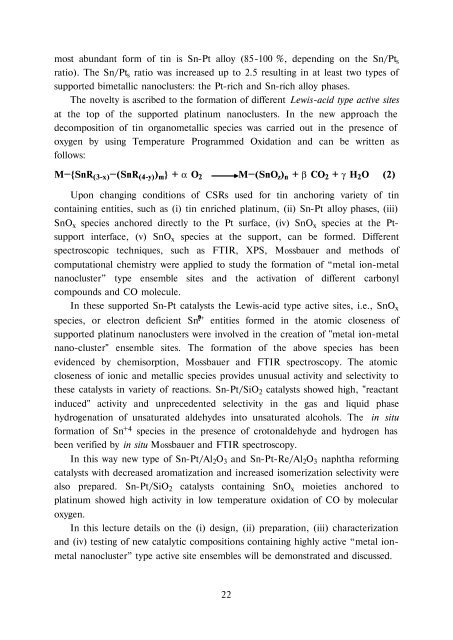ÐолекÑлÑÑнÑй дизайн каÑализаÑоÑов и каÑализ в пÑоÑеÑÑÐ°Ñ ...
ÐолекÑлÑÑнÑй дизайн каÑализаÑоÑов и каÑализ в пÑоÑеÑÑÐ°Ñ ...
ÐолекÑлÑÑнÑй дизайн каÑализаÑоÑов и каÑализ в пÑоÑеÑÑÐ°Ñ ...
You also want an ePaper? Increase the reach of your titles
YUMPU automatically turns print PDFs into web optimized ePapers that Google loves.
most abundant form of tin is Sn-Pt alloy (85-100 %, depending on the Sn/Pt s<br />
ratio). The Sn/Pt s ratio was increased up to 2.5 resulting in at least two types of<br />
supported bimetallic nanoclusters: the Pt-rich and Sn-rich alloy phases.<br />
The novelty is ascribed to the formation of different Lewis-acid type active sites<br />
at the top of the supported platinum nanoclusters. In the new approach the<br />
decomposition of tin organometallic species was carried out in the presence of<br />
oxygen by using Temperature Programmed Oxidation and can be written as<br />
follows:<br />
M–{SnR (3-x) –(SnR (4-y) ) m } + a O 2 M–(SnO z ) n + b CO 2 + g H 2 O (2)<br />
Upon changing conditions of CSRs used for tin anchoring variety of tin<br />
containing entities, such as (i) tin enriched platinum, (ii) Sn-Pt alloy phases, (iii)<br />
SnO x species anchored directly to the Pt surface, (iv) SnO x species at the Ptsupport<br />
interface, (v) SnO x species at the support, can be formed. Different<br />
spectroscopic techniques, such as FTIR, XPS, Mossbauer and methods of<br />
computational chemistry were applied to study the formation of “metal ion-metal<br />
nanocluster” type ensemble sites and the activation of different carbonyl<br />
compounds and CO molecule.<br />
In these supported Sn-Pt catalysts the Lewis-acid type active sites, i.e., SnO x<br />
species, or electron deficient Sn ? δ+<br />
entities formed in the atomic closeness of<br />
supported platinum nanoclusters were involved in the creation of "metal ion-metal<br />
nano-cluster" ensemble sites. The formation of the above species has been<br />
evidenced by chemisorption, Mossbauer and FTIR spectroscopy. The atomic<br />
closeness of ionic and metallic species provides unusual activity and selectivity to<br />
these catalysts in variety of reactions. Sn-Pt/SiO 2 catalysts showed high, "reactant<br />
induced" activity and unprecedented selectivity in the gas and liquid phase<br />
hydrogenation of unsaturated aldehydes into unsaturated alcohols. The in situ<br />
formation of Sn +4 species in the presence of crotonaldehyde and hydrogen has<br />
been verified by in situ Mossbauer and FTIR spectroscopy.<br />
In this way new type of Sn-Pt/Al 2 O 3 and Sn-Pt-Re/Al 2 O 3 naphtha reforming<br />
catalysts with decreased aromatization and increased isomerization selectivity were<br />
also prepared. Sn-Pt/SiO 2 catalysts containing SnO x moieties anchored to<br />
platinum showed high activity in low temperature oxidation of CO by molecular<br />
oxygen.<br />
In this lecture details on the (i) design, (ii) preparation, (iii) characterization<br />
and (iv) testing of new catalytic compositions containing highly active “metal ionmetal<br />
nanocluster” type active site ensembles will be demonstrated and discussed.<br />
22
















